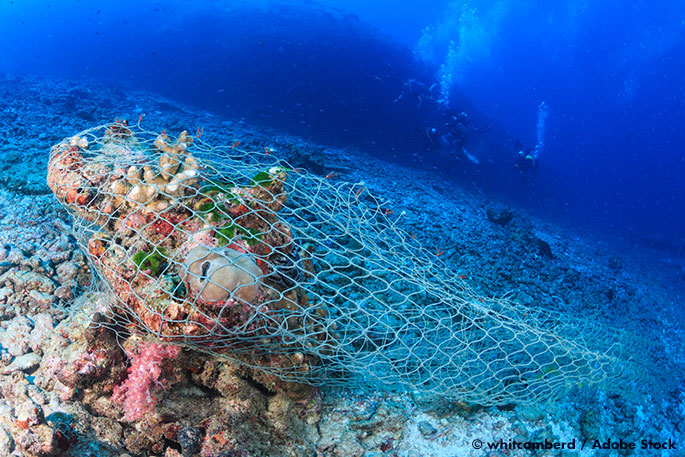Sick Seas
If you were one of the millions of viewers that watched the second installment of the acclaimed Blue Planet series, you are painfully aware of its alarming message: the oceans are in need of some serious TLC. Climate change, fishing industry pollution, and overfishing are some of the challenges that face our oceans today. It may surprise you, however, to learn who exactly is the biggest killer of our ocean’s marine life:
No one.
They call it ghost-fishing. Essentially, hundreds of miles of fishing lines and nets are abandoned by fisherman at sea and left to freely drift in the ocean currents. In doing so, these nets continue “fishing” and arbitrarily kill hundreds of species of marine life. Because of the fishing gear’s durable composition, ghost-fishing can persist for years and continually deplete fishing stocks and entangle wildlife, making it one of the deadliest hazards for our oceans.
Yet there are teams out there that are determined to integrate discarded fishing gear into the recycling developments chain. The scope and complexity of the challenge is colossal, but there is progress being made.
How to Recycle the Un-Recyclable
In 2018, the World Wildlife Fund (WWF) organized a workshop that took place in Germany, with the goal of circulating discussion on recycling methods for discarded fishing gear. As you can imagine, recycling industrial fishing gear is a bit more complicated than placing it in a blue bin and having it taken to a recycling facility. Think of removing that hair clog from the bathtub drain and then trying to separate and clean individual strands…yuck.
Fishing gear is often comprised of multiple chemical and material compounds, some of which are polluted with hazardous materials such as lead. The materials harvested from the oceans must be cleaned, separated, analyzed, and then shredded before undergoing essentially 1 of 3 recycling development processes. These were the most promising techniques that were reviewed at the WWF workshop in Germany:
- Melting: For materials that are deemed safe enough to liquefy, the shredded fishing nets can be melted down and molded into plastic materials. Alternatively, it may be converted to plastic pellets, which can undergo further processing for plastic-based products.
- Burning: This process requires further testing to understand the full effects of incinerating shredded fishing gear, but there is a promising indication that the leftover compounds could one day be converted into fuel for the shipping industry.
- Gassing: The official, scientific term is “hydrolysis.” In this method, no cleaning of the collected debris is required. In a complex series of chemical filtration systems, the material is effectively heated and separated into various gaseous forms. At the end of the process, the only remaining component is syngas. This chemical byproduct has many uses, but is most commonly used in the production of electricity.
To read the complete and detailed summary of the World Wildlife Fund’s findings on recycling fishing gear, click here.
Every. Line. Counts.
Abandoned fishing gear in our oceans is just one aspect of fishing industry plastic pollution. In the ideal world, a complete overhaul of the fishing industry worldwide might see our oceans restored to their former prolific bounties. It will take an immense allocation of manpower, resources and time to make the process of recycling fishing gear an effective and practical system. An oceanic-sized investment, but with returns that will benefit anyone who depends on our oceans for the health of our planet.
And that means everyone.
Sources:
(2018, June 20). What’s happening with fishing net recycling? Retrieved from http://www.kimointernational.org/news/whats-happening-with-fishing-net-recycling/
(2018, Nov. 30). New released report – Recycling options for DFG. Retrieved from https://www.marelittbaltic.eu/news/2018/10/30/new-released-report-recycling-options-for-dfg





































































































































 Three Ways to Engage Teams and Clients to Maximize Your Recycling Program Engagement
Three Ways to Engage Teams and Clients to Maximize Your Recycling Program Engagement  How to Integrate Accessibility Into Your Sustainability Planning
How to Integrate Accessibility Into Your Sustainability Planning  Why Park Benches Can Promote Workplace Well-Being
Why Park Benches Can Promote Workplace Well-Being 
